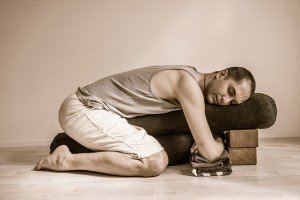What is Restorative Yoga
 Restorative Yoga has it’s foundation in the work of BKS Iyengar who pioneered the use of props to help support the body in Yoga postures. Iyengar style teachers such as Judith Lasater too have promoted and written extensively on the approach.
Restorative Yoga has it’s foundation in the work of BKS Iyengar who pioneered the use of props to help support the body in Yoga postures. Iyengar style teachers such as Judith Lasater too have promoted and written extensively on the approach.
However our approach here has been heavily influenced by our teacher Donna Farhi. Donna has been exemplary and inspiring in her integrity and development of restorative Yoga. Her approach is firmly grounded in natural movement principles and in a deep understanding of the Yoga tradition as a practice which may be applied to all aspects of life.
The Relaxation Response
Restorative Yoga is all about the relaxation response. In a culture which seems to promote and reward “doing” and “being productive” as the only “valuable” way to live, Restorative Yoga is counter-cultural, perhaps even “revolutionary”.
It invites “being” rather than “doing”, contentment rather than striving, being open rather than insensitive.
While initially appearing easy, like “Lying Around”, Restorative Yoga may be seen as a more advanced form, more akin to meditation, where we have the time to observe sensations, our breath, our emotions and mind, and where we may welcome all of these experiences. This is not necessarily easy at all. We may come face to face with aspects of ourselves which are not comfortable to be with. In more active Yoga we may be so busy with our “Yoga Practice” we don’t give ourselves the time and space to notice these deeper levels.
In truth though, this is where the Yoga tradition is guiding us … a fuller exploration of our whole selves - all of us - our body yes, and also our energy, breath, emotions, mind and spirit. It is a very holistic tradition. Yoga moves us gently and with ease towards a beautiful equanimity and neutrality, where we may welcome our full experience with open hearts to whatever happens in our life.
Whatever posture we practice, we set ourselves up so that every joint in our body is supported and we can allow gravity itself to work it’s magic and release held tension.
In the Restorative Yoga practice itself we use props such as bolsters and blankets to rest over, setting up these props very carefully and mindfully in a way that is suitable for us (and this may be different from the next person). The posture may be a forward or backward bend, it may be an inversion, supine or prone. Whatever posture we practice, we set ourselves up so that every joint in our body is supported and we can allow gravity itself to work it’s magic and release held tension. Every posture should feel sustainable, incredibly comfortable and even luxurious. Why not give this to ourselves?
Without the distraction of an uncomfortable body, we have the freedom to soften and release deeply, to ease through layers of tension, into profound relaxation, quietness and stillness. Why stillness? The simple answer is to quote a much loved teacher who now resides in the USA - Baba Hari Das:
When the mind is silent, the heart speaks. The language of the heart is love, compassion and peace.
The more we can anchor into this ground of silence - and Restorative Yoga gives us the tools for this - the more we may respond to whatever happens in our life from our True Nature, which is love, compassion, peace and kindness.
We hope that you may find the practices and teachings on this website an invaluable tool for your Yoga and your life.
Neal Ghoshal